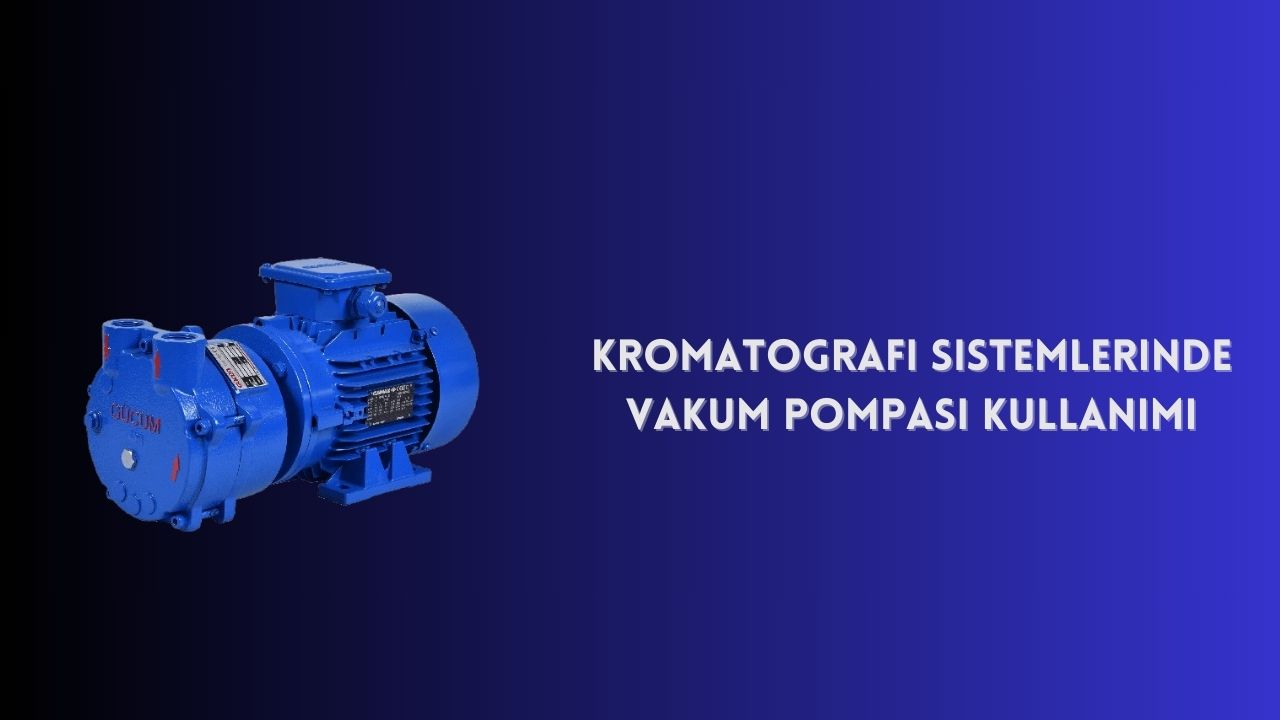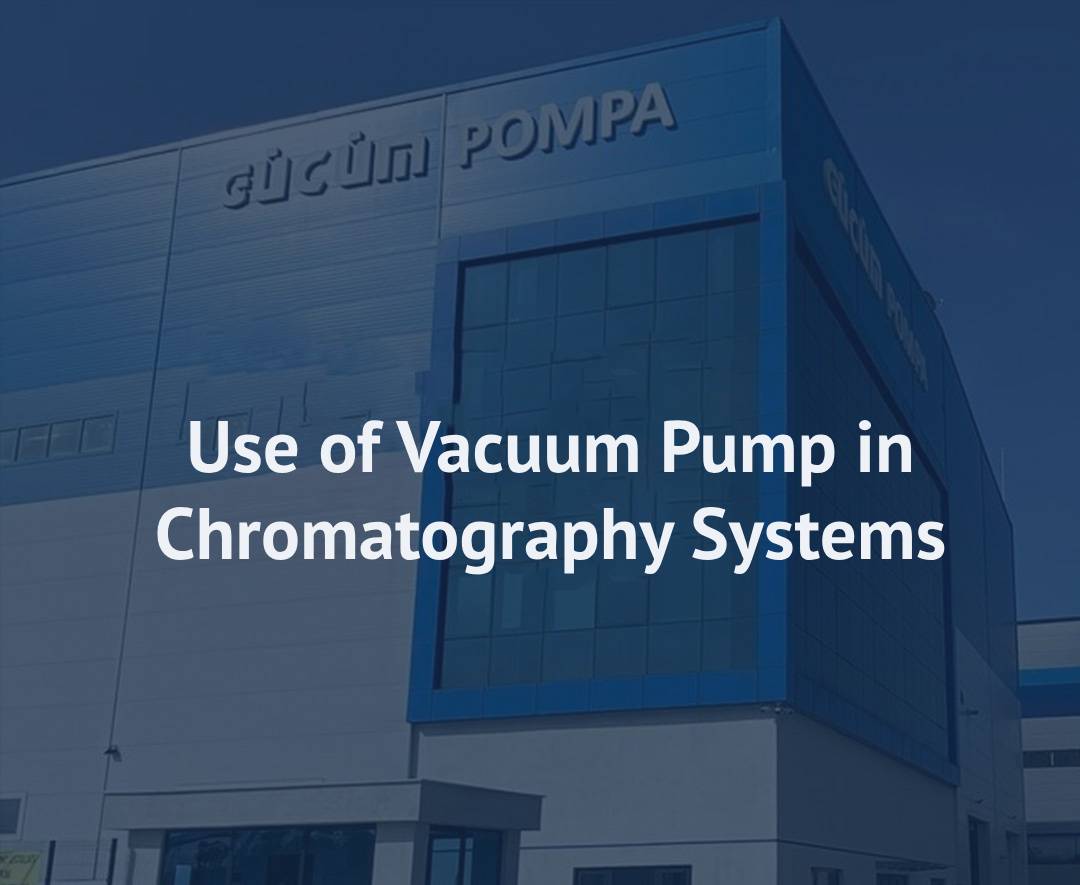Use of Vacuum Pump in Chromatography Systems
What is Chromatography?
Chromatography is a technique that enables the separation of components in a mixture based on their physical or chemical properties. Essentially, it involves the components moving at different speeds between a mobile phase (usually a liquid or gas) and a stationary phase (solid or liquid). This method is among various techniques used in sample analysis and is commonly employed in fields such as chemical analysis, biotechnology, pharmaceutical production, and environmental analytics. In chromatography systems, vacuum facilitates more efficient movement of the mobile phase, allowing for clearer and faster separation of components.

The Role of Vacuum Pumps in Chromatography Systems
Vacuum pumps perform several key functions in chromatography systems. During the chromatography process, vacuum is used to control the speed, pressure, and flow of the gas or liquid mobile phase. This plays a critical role, particularly in liquid chromatography (HPLC) and gas chromatography (GC). The effect of vacuum contributes to both improving resolution and shortening analysis times.
Vacuum pumps are generally used for two main purposes: first, in systems like gas chromatography, they ensure a steady and consistent flow of the carrier gas. Second, in liquid chromatography, they regulate the flow of the mobile phase, providing faster and more effective resolution. Vacuum also removes air and moisture from the system, enhancing resolution quality and system accuracy. This provides a significant advantage, especially in laboratory applications requiring high precision and reliability.
Contributions of Vacuum Pump Usage to Chromatography Systems
Vacuum pumps offer significant contributions to chromatography systems. These contributions enhance the overall performance, accuracy, and efficiency of the system. Here are some of the contributions of vacuum pumps in chromatography systems:
-
Improving System Performance: Vacuum regulates the speed and flow of the mobile phase during chromatography. This enables faster and more efficient separation of samples. Additionally, in systems like gas chromatography, vacuum ensures a consistent flow of the carrier gas, leading to more accurate results.
-
Enhancing Resolution and Separation Capabilities: Another key role of vacuum is improving resolution. The smoother flow of the mobile phase due to vacuum allows for better separation of components. This increases chromatographic resolution, enabling cleaner and clearer analysis results.
-
System Efficiency and Time Savings: Vacuum increases the speed of chromatography processes. This shortens analysis times and boosts laboratory efficiency. Especially in high-volume analyses, the impact of vacuum can be significant, as it accelerates processes, allowing more samples to be processed simultaneously.
-
Regulating Carrier Gas Flow: In gas chromatography (GC) systems, the flow of the carrier gas is controlled by vacuum. This ensures more stable and accurate results. Vacuum facilitates a steady flow rate of the carrier gas, reducing the margin of error in separation and analysis.
-
Reducing Aeration: Removing air and moisture from chromatography systems increases the accuracy and purity of samples. Vacuum pumps remove such unwanted components from the system, ensuring cleaner and more reliable results.
Use of Vacuum Pumps in Different Chromatography Methods
Vacuum pumps are used differently in various chromatography methods. Both liquid chromatography and gas chromatography benefit from vacuum pumps. The type of vacuum and pumps used in these systems varies depending on the specific requirements of the system.
Use of Vacuum Pumps in Gas Chromatography
Gas chromatography (GC) is a technique used to separate volatile components. In this system, vacuum pumps regulate the flow of the carrier gas. The carrier gas, typically an inert gas like helium or nitrogen, needs to flow at a consistent speed. Vacuum ensures that these gases flow at the correct speed and steadily, improving the accuracy of analyses. Additionally, vacuum removes air and moisture from the system, enabling cleaner and more accurate analyses.
Use of Vacuum Pumps in Liquid Chromatography
Liquid chromatography (HPLC) is a method used to separate liquid samples. In HPLC systems, vacuum regulates the flow of the mobile phase and eliminates air bubbles, providing a more stable flow. Vacuum increases the speed of the mobile phase, improving resolution and enabling better separation of components. Additionally, vacuum ensures more efficient movement of the mobile phase, shortening analysis times.
Selection of Vacuum Pumps in Chromatography Systems
Vacuum pump selection varies depending on the type of application and requirements used in chromatography systems. Different chromatography systems require different types of vacuum pumps. Here are some types of vacuum pumps that can be used in chromatography systems:
-
Rotary Vane Vacuum Pumps: These types of vacuum pumps are suitable for low and medium vacuum levels and are widely used in liquid chromatography (HPLC) systems. They are known for their high efficiency and durability.
-
Diaphragm (Capsule) Vacuum Pumps: Used to remove air and other gases, these pumps are preferred in systems like gas chromatography. They are ideal for high-precision and low-volume vacuum needs.
-
Dry Scroll Vacuum Pumps: These pumps, which operate dry, are suitable for both liquid chromatography and gas chromatography. They are used to provide fast and efficient vacuum.
-
Diffusion Vacuum Pumps: Suitable for high vacuum requirements, these pumps are used in more sensitive applications like biotechnology. Capable of achieving high vacuum levels, they are particularly ideal for gas chromatography.
Vacuum pumps play a critical role in chromatography systems. These pumps are used to enhance the accuracy, resolution, and efficiency of analyses. Vacuum ensures the steady flow of the carrier gas or mobile phase in different chromatography techniques, such as gas and liquid chromatography, aiding in the more efficient separation of samples. Careful selection and maintenance of vacuum pumps are necessary for the proper functioning of the systems. These technologies play a significant role in fields such as biotechnology, chemistry, pharmaceuticals, and environmental sciences.
Chromatography is a technique that enables the separation and analysis of chemical components. Frequently used in chemistry and biotechnology, this method relies on components moving at different speeds between various phases. Chromatography systems require high precision to obtain accurate analyses. One of the critical pieces of equipment used in this process is vacuum pumps. Vacuum pumps play a significant role in improving the speed and accuracy of the chromatography process, optimizing the system’s performance.
Basic Principles of Chromatography Systems
Chromatography is an analytical technique used to separate the components of a mixture in a liquid or gas phase. This technique allows the different components in the mixture to move at varying speeds through a stationary phase (solid or liquid) based on their physical or chemical properties. Chromatography is commonly used in analytical laboratories, biotechnology industries, and pharmaceutical development processes.
The basic components of chromatography systems include a column, a mobile phase (liquid or gas), a stationary phase (solid or liquid), and a detector. The components of the sample moving through the system are separated through interactions between these phases. Among chromatography methods, gas chromatography (GC) and liquid chromatography (HPLC) are the most common. Both methods require vacuum pumps because vacuum regulates the flow of carrier gases or the mobile phase, enhancing the accuracy and speed of the analysis.
Main Purposes of Using Vacuum Pumps in Chromatography Systems
Vacuum pumps are used for various purposes in chromatography systems. Vacuum is particularly necessary to ensure that carrier gases move at a steady speed and to facilitate faster passage of the mobile phase. This enables faster separation of samples and analysis with higher resolution. Additionally, the use of vacuum helps remove air bubbles and moisture from the system, allowing for more stable results.
The role of vacuum pumps in chromatography processes becomes even more evident with the following key advantages:
-
Regulating Carrier Gas Flow: Vacuum regulates the speed of the carrier gas in gas chromatography. This ensures that components move through the column at the correct speed, aiding in clearer separation. Stabilizing the gas speed shortens analysis time while increasing resolution.
-
Improving Resolution: Vacuum accelerates the flow of the mobile phase, enhancing resolution. This allows components to move through the column more quickly, improving resolution and ensuring clearer separation of samples.
-
High Efficiency: Vacuum enables the chromatography process to be performed more quickly. This is especially a critical factor in industrial applications, as high-volume samples need to be processed rapidly. Thanks to vacuum, processing time is reduced, and efficiency increases.
-
Fast and Efficient Separation: Vacuum increases the speed of chromatographic separation. Particularly in liquid chromatography, the rapid movement of the mobile phase allows analysis to be completed in a shorter time. This boosts laboratory efficiency and saves time.
-
Air and Moisture Removal: Vacuum removes air bubbles and moisture from the system. Air can negatively impact chromatographic separation, as air bubbles during separation can distort resolution. Vacuum eliminates such issues, providing more reliable and accurate results.
Factors to Consider in Vacuum Pump Selection
The selection of vacuum pumps to be used in chromatography systems varies depending on the chromatography method used and the system’s needs. Choosing the right vacuum pump is critical for the system’s efficiency and accuracy. Some factors to consider when selecting a vacuum pump include:
-
Vacuum Level: The vacuum level provided by the vacuum pump varies depending on the application’s requirements. In systems with high vacuum needs, more powerful pumps may be necessary. While low to medium vacuum levels may suffice in gas chromatography, liquid chromatography may require more precise control.
-
Pump Capacity: The capacity of the vacuum pump should be determined based on the system’s processing volume. High-capacity pumps may be required for large-volume analyses, while smaller pumps may suffice for small to medium-scale analyses.
-
Pump Type: Various types of vacuum pumps, such as rotary vane vacuum pumps, diaphragm vacuum pumps, and dry scroll vacuum pumps, are commonly used in chromatography systems. The type to be used should be determined based on the system’s needs and application area.
-
Speed and Performance: The speed and performance of the vacuum pump are important for faster sample separation and shorter analysis times. Slow-operating pumps can negatively affect system efficiency, so fast and high-performance pumps should be preferred.
-
Maintenance and Durability: Maintenance of vacuum pumps is crucial for long-term and efficient use. High-quality and durable pumps experience fewer failures, ensuring system continuity. Additionally, ease of maintenance and pump durability are also factors influencing selection.
Types of Vacuum Pumps in Chromatography Systems
Vacuum pumps are produced in different types depending on various chromatography techniques and system requirements. Each pump type offers specific advantages and limitations. Here are the types of vacuum pumps commonly used in chromatography systems:
Rotary Vane Vacuum Pumps
Rotary vane vacuum pumps are a type of vacuum pump generally preferred in liquid chromatography systems.


